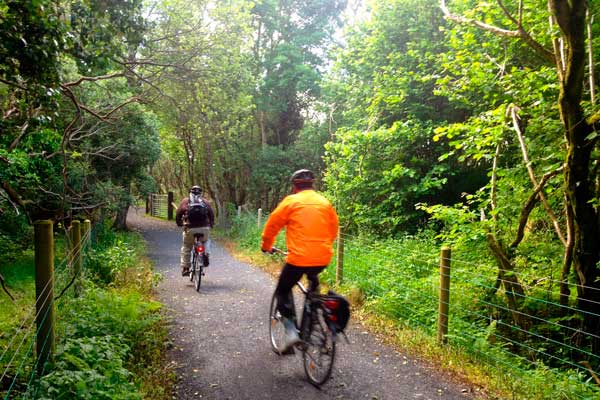If Joni Mitchell were writing her song ‘Big Yellow Taxi’ today, about the ruination of the natural world by the march of modernity, the lyrics might run something like this: ‘They paved paradise, put up a cycling route.’ Not content with demanding cycling lanes through our towns and cities, the cycling lobby — by which I don’t mean old maids bicycling to communion, I mean the Lycra brigade — are starting to turn the countryside into a surface on which they can pedal themselves into an endorphin-rich sweat as well, it seems.
The tarmacking of a six-mile track through unspoilt Warwickshire countryside near my parents’ home is the latest evidence of this. The Kenilworth Greenway, as it is now known, was a disused railway line before. As a child I remember blissful afternoons spent blackberry-picking along the grassy track bordered by wild banks of brambles. The dogs ran free, the horses cantered past. The track stretched from Kenilworth to the next village of Berkswell, with woods on one side and farming country on the other.
But it seems the good earth wasn’t good enough for the cyclist, nor for council bureaucrats, who think the countryside should offer more opportunities for ‘all members of our society’, including events where children can ‘get involved!’ — with a jaunty exclamation mark. And so, with the help of government funds and Lottery money, the track has been turned into a ‘multi-user natural pathway corridor’ or ‘linear country park’, as the website variously refers to it. Instead of a long grassy track stretching to the horizon, there is now a shiny black runway littered with ‘do’ and ‘don’t’ signs. Only a council could convert a green pathway into a black pathway and then call it a Greenway.
In reality, there is nothing multi-user about it, either. Horses can’t be ridden on it, because you can’t canter on tarmac. People can’t walk their dogs on it in peace, on account of the cyclists speeding up from behind — Whoosh! ‘Aaaagh! Christ, where’s the dog? Cydney!’
On the positive side, you can now walk on the path in Louboutin heels. It is very much the sort of pristine country ramble that would appeal to those who moan about their Hunters getting mud on them.
And of course it fulfils all kinds of diversity quotas. Here is what Warwickshire county council has to say about it (readers who suffer allergic reactions to extreme political correctness should look away now):
‘The Greenway, as well as being a linear Country Park, is a permissive bridleway which means that it can be used by pedestrians, cyclists and horse-riders, who will need to obtain an annual permit (see below).
‘The track is segregated with a natural grass track for horses and a firm track — made from recycled materials and Derbyshire limestone — for other users.
‘Open 365 days of the year.’
Good of them. ‘Admission: Free.’ But not to horse-riders, as explained. When I rang the ominously entitled countryside recreation manager at Warwickshire county council to find out more, Stuart Ickeringill was not there but the lady who answered the phone asked: ‘What element of the Greenway are you inquiring about?’
‘The tarmacking-of-miles-of-countryside element of it,’ I said.
‘You mean, the establishment of the Greenway,’ she said.
‘No,’ I said, ‘I mean, the tarmacking of miles of countryside.’
‘Fine,’ she said. ‘He will get back to you.’
In fact, Mr Ickeringill did seem to understand my concerns when he called back later. He explained that there had been a lot of discussion about the tarmac not looking very nice. ‘We even thought about spraying it with cow muck to make it look more natural,’ he revealed.
‘Did you ever think about not putting it down in the first place?’ I asked.
He explained that a lot of disabled people use the track now and that it ‘reconnects communities’. But I can’t think why anyone, disabled or otherwise, would spend two hours walking or wheeling themselves to the neighbouring village when they can drive there in ten minutes on the A452. So who is the tarmac really for?
The Greenway was built with £400,000 of Heritage Lottery funding, £400,000 from the government’s local transport plan and a donation of around £160,000 from a body called Sustrans, which was a driving force behind the project. Sustrans describes itself as ‘a leading UK charity enabling people to travel by foot, bike or public transport for more of the journeys we make every day’.
Sustrans is responsible for the National Cycle Network. It has created over 10,000 miles of signposted cycle routes throughout the UK, often through ‘green corridors’ like disused rail lines. Its patrons include Neil and Glenys Kinnock. It was formed by a group of cyclists in Bristol in 1977, and called Cyclebag then. It says it is motivated by ‘emerging doubts about the desirability of over-dependence on the private car’.
But here’s an interesting statistic: 35 per cent of usage on the urban sections of the cycle network is classed as leisure.
The Kenilworth Greenway is NCN pathway number 523, and one of 81 rural paths supposedly for the high-minded aim of connecting communities. But I’m not sure this is about facilitating people who use bicycles to actually get somewhere at all. As far as I can see, the only people riding their bikes on the Greenway are the men in Lycra. They hold races and rallies on it on Sundays. They speed past in their pelotons, shouting at dog-walkers to get out of the way as they do those weird time trials whereby groups of them compete against each other to see who can achieve the most preposterous feats of physical exertion without actually having a blood transfusion. They certainly don’t look like they are using the path to get to the next village to visit their Auntie Beryl. They look like the same helmeted spider-men who spend their weekends staging mini Tour de Frances on narrow lanes everywhere you go in the countryside nowadays.
Martyn Brunt, NCN development manager, said: ‘If we are seeing that kind of usage then that’s very disappointing. We have had incidents of that on other routes and we have published a code of conduct making clear it is not priority cycling. We want to encourage leisure and utility cycling, not sports cycling,’ he said.
Clearly, those who like to feel the earth beneath their wellies need to fight back. If we don’t, we might soon find (to paraphrase Joni again) that the only mud left is in a mud museum, where they charge all the people £1.50 to see it.
Don’t it always seem to go, that you don’t know what you’ve got till it’s gone?







Comments